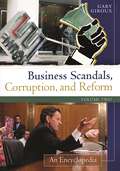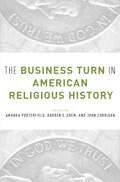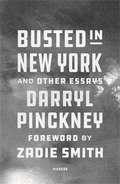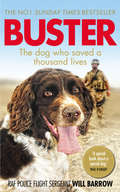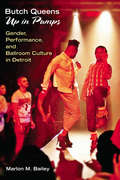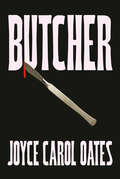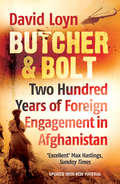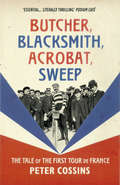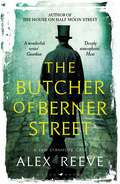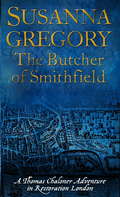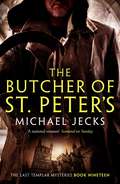- Table View
- List View
Business Scandals, Corruption, and Reform [2 volumes]: An Encyclopedia [2 volumes]
by Gary GirouxWritten by an expert on financial analysis and capitalism, this book describes the widespread corruption and specific scandals that have occurred throughout history when ethically-challenged innovators and greedy scoundrels are unable to resist the dark side of corruption.Since the dawn of civilization, corruption has had a perpetual impact on the world's economies. In the modern, technology-enabled, global economy, the effects of those who manipulate free-market capitalism for their own gains regardless of methodology continue to be a problem, despite reforms instituted to attempt to discourage the most blatant practices.Business Scandals, Corruption, and Reform: An Encyclopedia contains more than 300 entries that describe the myriad aspects of corruption, business scandals, and attempts at reform, providing not only detailed information about specific accounting scandals and earnings manipulation but also a broad examination of the entire history of business corruption throughout human civilization. Reviewing all the major scandals from tulip mania in the early 17th century to the subprime mortgage crisis of 2008 and beyond, the author illuminates how corrupt actors in business and the attempts to eliminate these types of abuses have been instrumental to the developing institutional framework of free-market capitalism.
Business Strategy and Competitive Advantage: A Reinterpretation of Michael Porter’s Work (Routledge Research in Strategic Management)
by Jovo Ateljević Dženan Kulović Filip Đoković Mirza BavčićMichael Porter is recognized as one of the top authorities on corporate strategy and business competition. The historical review of strategic management clearly shows that Porter’s research has bridged up two general paradigms (before and after the 1980s) thus helping both researchers and practitioners to better understand unanticipated global changes. His two generic strategies: costs and diversification, the two interdependent strategic options, are key in the context of the competitiveness of orthodox microeconomic theory. This is where Porter went further, constructing a popular value chain concept that provides the ability to disaggregate the key activities of business process in creating products and services in terms of cost analysis and value creation. This book is a collection of seven interconnected chapters that provides a coherent understanding of Michael Porter’s contribution to the field of strategic management. It addresses key changes and challenges in the global business environment. The value chain concept has become highly applicable in both theory and practice. In the book, the authors offer an original interpretation of the Porters’ research on strategic management in order to unravel or simplify his key theoretical concepts. It will be of interest to researchers, academics, practitioners, and students in the fields of strategic management and international business.
Business Strategy and Competitive Advantage: A Reinterpretation of Michael Porter’s Work (Routledge Research in Strategic Management)
by Jovo Ateljević Dženan Kulović Filip Đoković Mirza BavčićMichael Porter is recognized as one of the top authorities on corporate strategy and business competition. The historical review of strategic management clearly shows that Porter’s research has bridged up two general paradigms (before and after the 1980s) thus helping both researchers and practitioners to better understand unanticipated global changes. His two generic strategies: costs and diversification, the two interdependent strategic options, are key in the context of the competitiveness of orthodox microeconomic theory. This is where Porter went further, constructing a popular value chain concept that provides the ability to disaggregate the key activities of business process in creating products and services in terms of cost analysis and value creation. This book is a collection of seven interconnected chapters that provides a coherent understanding of Michael Porter’s contribution to the field of strategic management. It addresses key changes and challenges in the global business environment. The value chain concept has become highly applicable in both theory and practice. In the book, the authors offer an original interpretation of the Porters’ research on strategic management in order to unravel or simplify his key theoretical concepts. It will be of interest to researchers, academics, practitioners, and students in the fields of strategic management and international business.
BUSINESS TURN IN AMERIC RELIG HISTORY C
by Amanda Porterfield, John Corrigan and Darren E. GremBusiness has received little attention in American religious history, although it has profound implications for understanding the sustained popularity and ongoing transformation of religion in the United States. This volume offers a wide ranging exploration of the business aspects of American religious organizations. The authors analyze the financing, production, marketing, and distribution of religious goods and services and the role of wealth and economic organization in sustaining and even shaping worship, charity, philanthropy, institutional growth, and missionary work. Treating religion and business holistically, their essays show that American religious life has always been informed by business practices. Laying the groundwork for further investigation, the authors show how American business has functioned as a domain for achieving religious goals. Indeed they find that religion has historically been more powerful when interwoven with business. Chapters on Mormon enterprise, Jewish philanthropy, Hindu gurus, Native American casinos, and the wedding of business wealth to conservative Catholic social teaching demonstrate the range of new studies stimulated by the business turn in American religious history. Other chapters show how evangelicals joined neo-liberal economic practice and right-wing politics to religious fundamentalism to consolidate wealth and power, and how they developed marketing campaigns and organizational strategies that transformed the American religious landscape. Included are essays exposing the moral compromises religious organizations have made to succeed as centers of wealth and influence, and the religious beliefs that rationalize and justify these compromises. Still others examine the application of business practices as a means of sustaining religious institutions and expanding their reach, and look at controversies over business practices within religious organizations, and the adjustments such organizations have made in response. Together, the essays collected here offer new ways of conceptualizing the interdependence of religion and business in the United States, establishing multiple paths for further study of their intertwined historical development.
The Business Turn in American Religious History
Business has received little attention in American religious history, although it has profound implications for understanding the sustained popularity and ongoing transformation of religion in the United States. This volume offers a wide ranging exploration of the business aspects of American religious organizations. The authors analyze the financing, production, marketing, and distribution of religious goods and services and the role of wealth and economic organization in sustaining and even shaping worship, charity, philanthropy, institutional growth, and missionary work. Treating religion and business holistically, their essays show that American religious life has always been informed by business practices. Laying the groundwork for further investigation, the authors show how American business has functioned as a domain for achieving religious goals. Indeed they find that religion has historically been more powerful when interwoven with business. Chapters on Mormon enterprise, Jewish philanthropy, Hindu gurus, Native American casinos, and the wedding of business wealth to conservative Catholic social teaching demonstrate the range of new studies stimulated by the business turn in American religious history. Other chapters show how evangelicals joined neo-liberal economic practice and right-wing politics to religious fundamentalism to consolidate wealth and power, and how they developed marketing campaigns and organizational strategies that transformed the American religious landscape. Included are essays exposing the moral compromises religious organizations have made to succeed as centers of wealth and influence, and the religious beliefs that rationalize and justify these compromises. Still others examine the application of business practices as a means of sustaining religious institutions and expanding their reach, and look at controversies over business practices within religious organizations, and the adjustments such organizations have made in response. Together, the essays collected here offer new ways of conceptualizing the interdependence of religion and business in the United States, establishing multiple paths for further study of their intertwined historical development.
Businessman in the Statehouse: Six Years as Governor of North Carolina
by Luther H. HodgesThis is the story of Governor Hodges's years in the statehouse, told in his own words. It is lively, forceful, and honest--like the man himself. It is particularly relevant to the concept that states' rights should be regarded as a challenge to make state government honest, responsible, and forward looking.Originally published in 1962.A UNC Press Enduring Edition -- UNC Press Enduring Editions use the latest in digital technology to make available again books from our distinguished backlist that were previously out of print. These editions are published unaltered from the original, and are presented in affordable paperback formats, bringing readers both historical and cultural value.
Busks, Basques and Brush-Braid: British dressmaking in the 18th and 19th centuries
by Pam InderThe dressmaking trade developed rapidly during the 18th and 19th centuries, changing the lives of thousands of British workers. Busks, Basques and Brush-Braid focuses on the trade and the people within it, from their working conditions and earnings to their training, services and relationships with customers. Exploring the lives of dressmakers in fact and fiction, the book looks at representations of the trade in the plays and novels of the time, while surveying the often harsh realities of the workers' lives. From the arrival of the sewing machine to the influence of the department store, it explores the impact of mechanization, commercialization and modernity on a historical trade. Pamela Inder illuminates a new world of dressmaking enabled by goods like paper patterns and magazines, and sets out to investigate the increasing monopoly of female dressmakers in an industry once dominated by male tailors.Drawing on a range of original and hitherto unpublished sources – including business records, diaries, letters, bills and newspaper articles – Busks, Basques and Brush-Braid reveals the untold story of the dressmaking trade. Beautifully illustrated with over 80 images, the book brings dressmakers into focus as real people, granting new insights into working class life in 18th- and 19th-century Britain.
Busks, Basques and Brush-Braid: British dressmaking in the 18th and 19th centuries
by Pam InderThe dressmaking trade developed rapidly during the 18th and 19th centuries, changing the lives of thousands of British workers. Busks, Basques and Brush-Braid focuses on the trade and the people within it, from their working conditions and earnings to their training, services and relationships with customers. Exploring the lives of dressmakers in fact and fiction, the book looks at representations of the trade in the plays and novels of the time, while surveying the often harsh realities of the workers' lives. From the arrival of the sewing machine to the influence of the department store, it explores the impact of mechanization, commercialization and modernity on a historical trade. Pamela Inder illuminates a new world of dressmaking enabled by goods like paper patterns and magazines, and sets out to investigate the increasing monopoly of female dressmakers in an industry once dominated by male tailors.Drawing on a range of original and hitherto unpublished sources – including business records, diaries, letters, bills and newspaper articles – Busks, Basques and Brush-Braid reveals the untold story of the dressmaking trade. Beautifully illustrated with over 80 images, the book brings dressmakers into focus as real people, granting new insights into working class life in 18th- and 19th-century Britain.
Bussaco 1810: Wellington defeats Napoleon's Marshals (Campaign #97)
by René Chartrand Patrice CourcelleBy 1810, Napoleon reigned supreme over most of continental Europe. But the Iberian Peninsula remained unsubdued, particularly Portugal, which continued to resist. Napoleon ordered Marshal Masséna to crush this resistance with the Army of Portugal. Greatly strengthened, Masséna's army would drive the Portuguese and British into the sea. Facing the French were 60,000 British and Portuguese troops. No-one knew how the Portuguese would perform in battle, but on 27 September 1810, they received their baptism of fire. This title details the gruelling Bussaco campaign as French attempts to subdue Portugal reached their climax.
Bussaco 1810: Wellington defeats Napoleon's Marshals (Campaign #97)
by René Chartrand Patrice CourcelleBy 1810, Napoleon reigned supreme over most of continental Europe. But the Iberian Peninsula remained unsubdued, particularly Portugal, which continued to resist. Napoleon ordered Marshal Masséna to crush this resistance with the Army of Portugal. Greatly strengthened, Masséna's army would drive the Portuguese and British into the sea. Facing the French were 60,000 British and Portuguese troops. No-one knew how the Portuguese would perform in battle, but on 27 September 1810, they received their baptism of fire. This title details the gruelling Bussaco campaign as French attempts to subdue Portugal reached their climax.
Bust: How the Courts Have Exposed the Rotten Heart of the Irish Economy
by Dearbhail McDonaldWhen, after fifteen years of runaway growth based largely on property speculation, the Irish economy finally crashed, Ireland's bankers and developers tried to keep themselves out of sight. But they couldn't keep themselves out of court - and it is in the courtrooms that the full, sickening drama of the Irish meltdown is being played out. Dearbhail McDonald, the brilliant legal editor of the Irish Independent, has been following the high-stakes rows through the courts and, drawing upon her unmatched contacts, tells the often bizarre stories behind an extraordinary reversal of fortune. From the man who ran a pyramid scheme in a Dublin suburb to the leading developer whose business now lies in ruins, from the judges to the solicitors to the ordinary mortgage-holders who find themselves on the wrong side of the law, Bust paints a gripping picture of the human drama - and the human cost - of an economic catastrophe.
Busted in New York & Other Essays: with an introduction by Zadie Smith
by Darryl Pinckney'[Pinckney] reveals himself to be a skilful chronicler of black experience in literary criticism, reportage and biography' The New York Times In these twenty-five essays, Darryl Pinckney has given us a view of our recent racial history that blends the social and the personal and wonders how we arrived at our current moment. Pinckney reminds us that "white supremacy isn't back; it never went away." It is this impulse to see historically that is at the core of Busted in New York and Other Essays, which traces the lineage of black intellectual history from Booker T. Washington through the Harlem Renaissance, to the Black Panther Party and the turbulent sixties, to today's Afro-pessimists, and celebrated and neglected thinkers in between.These are capacious essays whose topics range from the grassroots of protest in Ferguson, Missouri, to the eighteenth-century Guadeloupian composer Joseph Bologne, from an unsparing portrait of Louis Farrakhan to the enduring legacy of James Baldwin, the unexpected story of Black people experiencing Russia, Barry Jenkins's Moonlight, and the painter Kara Walker. The essays themselves are a kind of record, many of them written in real-time, as Pinckney witnesses the Million Man March, feels and experiences the highs and lows of Obama's first presidential campaign, explores the literary Black diaspora, and reflects on the surprising and severe lesson he learned firsthand about the changing urban fabric of New York.As Zadie Smith writes in her introduction to the book: "How lucky we are to have Darryl Pinckney who, without rancor, without insult, has, all these years, been taking down our various songs, examining them with love and care, and bringing them back from the past, like a Sankofa bird, for our present examination. These days Sankofas like Darryl are rare. Treasure him!
Buster: The dog who saved a thousand lives
by RAF Police Sergeant Will Barrow Isabel GeorgeThe Sunday Times Top Ten BestsellerThousands of lives have been saved by this spaniel. He is a best friend in dog’s clothing. An RAF dog with his mossy feet firmly on the ground. A brave dog who has served his colleagues and his country with unstinting devotion. A dog in a million.This is the story of the partnership of Buster and Will, told by Will himself, describing how each came to save the other’s life. This is a relationship that produced some heroic feats in the dust and desert heat of Afghanistan - and beyond. Buster, uniquely, has served five tours of duty - more than any other military dog. “With some dogs you share a boil in the bag breakfast and maybe a blanket on a cold desert floor. Some you wouldn’t leave in charge of your Grandma unless you wanted to find out just how fast the old girl could run. But, if you’re very, very lucky there will be the one dog you would lay down your life for – and for me that dog is Buster.”As told to Isabel George.
'Buster' Crabb: Ian Fleming’s Favourite Spy, The Inspiration for James Bond
by Don HaleCommander Lioinel 'Buster' Crabb was Ian Fleming's inspiration for James Bond. A British naval frogman, Crabb disappeared under mysterious circumstances in 1957 following a secret dive beneath a Russian warship which brought Soviet leaders Khrushchev and Bulganin to Britain. Fifty years after the event, award-winning investigative journalist Don Hale uncovers who sanctioned Crabb's final dive in a case which claimed the jobs of Admiralty top brass and Intelligence people and contributed to the downfall of Prime Minister Anthony Eden.
Busty, Slag and Nob End
by Russell AshBuilding on the phenomenal success of POTTY, FARTWELL AND KNOB, this new collection of extraordinary but true names goes a step further...In BUSTY, SLAG AND NOB END, Russell Ash has compiled real names from around the world that are really rude and are of places and products as well as people. The result of painstaking research, each name has been thoroughly checked and authenticated: you will marvel at the range of naughty nomenclature and hoot at the unwitting innuendo. From Harriet Nicewonger (born Derbyshire c.1876) and Connie Lingus (resident of Indiana, USA) to Dick Swinger (born Switzerland c.1842) and Blo Job (US immigrant from Slovakia, born c.1897); from Titty Ho in Northamptonshire to Dildo in Newfoundland; and from Cock Soup to Pee Cola - this compendium of sauciness is guaranteed to make you laugh out loud.
But You Did Not Come Back
by Marceline Loridan-IvensMarceline Loridan-Ivens was just fifteen when she was arrested by the Vichy government's militia, along with her father. He prepared her for the worst, telling her that he would not return. They were soon separated. The three kilometres between her father in Auschwitz and herself in Birkenau were an insurmountable distance, and yet he managed to send her a small note via an electrician in the camp - a sign of life.In But You Did Not Come Back, Marceline writes a letter to the father she would never know as an adult, to the man whose death enveloped her whole life. Her testimony is a haunting and challenging reminder of one of the worst crimes humanity has ever seen, and an affecting personal story of a woman whose life was shattered and never totally rebuilt.
Butch Queens Up in Pumps: Gender, Performance, and Ballroom Culture in Detroit (Triangulations: Lesbian/Gay/Queer Theater/Drama/Performance)
by Marlon M BaileyButch Queens Up in Pumpsexamines Ballroom culture, in which inner-city LGBT individuals dress, dance, and vogue to compete for prizes and trophies. Participants are affiliated with a house, an alternative family structure typically named after haute couture designers and providing support to this diverse community. Marlon M. Bailey’s rich first-person performance ethnography of the Ballroom scene in Detroit examines Ballroom as a queer cultural formation that upsets dominant notions of gender, sexuality, kinship, and community.
Butcher
by null Joyce Carol OatesFrom one of our most accomplished storytellers, an extraordinary and arresting novel about a women’s asylum in the nineteenth century, and a terrifying doctor who wants to change the world. In this harrowing story based on authentic historical documents, we follow the career of Dr. Silas Weir, “Father of Gyno-Psychiatry,” as he ascends from professional anonymity to national renown. Humiliated by a procedure gone terribly wrong, Weir is forced to take a position at the New Jersey Asylum for Female Lunatics, where he reigns. There, he is allowed to continue his practice, unchecked for decades, making a name for himself by focusing on women who have been neglected by the state—women he subjects to the most grotesque modes of experimentation. As he begins to establish himself as a pioneer of nineteenth-century surgery, Weir’s ambition is fueled by his obsessive fascination with a young Irish indentured servant named Brigit, who becomes not only Weir’s primary experimental subject, but also the agent of his destruction. Narrated by Silas Weir’s eldest son, who has repudiated his father’s brutal legacy, Butcher is a unique blend of fiction and fact, a nightmare voyage through the darkest regions of the American psyche conjoined, in its startling conclusion, with unexpected romance. Once again, Joyce Carol Oates has written a spellbinding novel confirming her position as one of our celebrated American visionaries of the imagination. ‘Simply the most consistently inventive, brilliant, curious and creative writer going, as far as I’m concerned’ Gillian Flynn, author of Gone Girl 'A master storyteller' The Times
Butcher and Bolt: Two Hundred Years Of Foreign Failure In Afghanistan
by David LoynAfghanistan has been a strategic prize for more than 200 years. Foreign invaders have continually fought across its beautiful and inhospitable terrain, in conflicts variously ruthless, misguided and bloody. A century ago, the common sneer about how British soldiers treated Afghan tribesmen was that they would 'butcher' them, then 'bolt'. Butcher and Bolt recounts this violent history, beginning with the very first British mission - an encounter that ushered in two centuries of conflict littered with misunderstandings and broken promises, in which the British, the Russians and later the Americans repeatedly underestimated the ability of the Afghans and the power of the Frontier tribes. In a new final chapter that brings the book right up to date, David Loyn draws on the unique access he has had to Afghanistan over the past two decades to address the emerging threat of the Pakistani Taliban and the challenges that face those now fighting on the most dangerous frontier in the world.
Butcher, Baker, Candlestick Maker: Surviving the Great Fire of London
by Hazel ForsythHazel Forsyth delvesin to never-before-studied primary sources to shed light on thedramatic aftermath of the disaster and reveal the very personalstories of the people who pieced their lives together in its wake. Bydocumenting the tradesmen, from apothecaries and chandlers toshoemakers and watchmakers, Butcher, Baker, Candlestick Makertells a story of loss and resilience and illuminates how the citywe know today rose from the ashes. Beautifully illustrated withexquisite fabrics, candle snuffers and other fascinating imagesassociated with the trades of the time, we are treated to a visualfeast, an evocative reminder of life before and after the Great Fire.
The Butcher Bird: Oswald de Lacy Book 2 (Oswald de Lacy #2)
by S D SykesBook 2 in the gripping Oswald de Lacy series, , which can be read as a standalone, from 'the medieval CJ Sansom' (Jeffery Deaver)The Black Death killed his father and brothers , making Oswald de Lacy Lord of Somershill Manor. It also killed many of his villagers, leaving fewer people to do more work.So Oswald tries to use logic and patience to manage a struggling estate, a socially ambitious mother, an overbearing sister and a mutinous workforce.Then a baby is found impaled on a thorn bush and people say they have seen a huge creature in the skies. The Butcher Bird.And now there is no room for common sense, no time for patience. If Oswald is to survive, he must find the truth behind a series of ever more brutal events.From the plague-ruined villages of Kent to the luxurious bedchambers of London, it is a journey full of danger, darkness and shocking revelations.'The whodunnit aspect is neatly done, the family secrets and waspish relationships are intriguing, and humour and originality are abundant' Daily Mail
Butcher, Blacksmith, Acrobat, Sweep: The Tale of the First Tour de France
by Peter CossinsThe first Tour de France in 1903 was a colourful affair full of adventure, mishaps and audacious attempts at cheating. Its riders included characters like Maurice Garin, an Italian-born Frenchman, said to have been swapped for a round of cheese by his parents in order to smuggle him into France to clean chimneys as a teenager, Hippolyte Aucouturier with his trademark handlebar moustache, and amateurs like Jean Dargassies, a blacksmith who had never raced before. Would this ramshackle pack of cyclists draw crowds to throng France's rutted roads and cheer the first Tour heroes? Surprisingly it did, and, all thanks to a marketing ruse dreamed up to revive struggling newspaper L'Auto, cycling would never be the same again. Peter Cossins takes us through the inaugural Tour de France, painting a nuanced portrait of France in the early 1900s, to see where the greatest sporting event of all began.
The Butcher of Berner Street
by Alex ReeveThe latest atmospheric mystery from the author of the Richard and the Judy Book Club choice, The House on Half Moon Street. The headlines scream warnings about the 'Butcher of Berner Street!' and the journalist behind them – Leo Stanhope – is secretly thrilled to see the effect his words are having. Leo's previous work has largely been concentrated on more mundane issues but when an anonymous letter summons him to a club in East London, only for the owner of the club to be found murdered shortly afterwards, Leo sees a story worth pursuing. Not to mention an opportunity to make a name for himself. Yet the more Leo digs, the stranger the story becomes, taking him from the club to a nearby convent, and into the past of a very unusual woman. But he is not the only one hunting for a killer. And it seems Leo's newspaper reports may have put someone else in grave danger… Praise for the Leo Stanhope series 'Reeve has not only crafted a brilliant crime novel, but has created a character who has made me see the world with new eyes' i'Exceptional – you hear and smell and taste Victorian London' Sarah Hilary 'A deeply atmospheric thriller with more twists and turns than the grubby streets of London, and a central character we really care about' Heat
The Butcher Of Smithfield: 3 (Adventures of Thomas Chaloner #3)
by Susanna GregoryThe third adventure in the Thomas Chaloner series.Having just returned from a clandestine excursion to Spain and Portugal on behalf of the Queen, Thomas Chaloner finds London dank and grey under leaden skies. He finds many things changed, including the Government slapping a tax on printed newspapers. Handwritten news reports escape the duty, and the rivalry between the producers of the two conduits of news is the talk of the coffee houses with the battle to be first with any sort of intelligence escalating into violent rivalry. And it seems that a number of citizens who have eaten cucumbers have come to untimely deaths. It is such a death which Chaloner is despatched to investigate; that of a lawyer with links to 'the Butcher of Smithfield', a shady trader surrounded by a fearsome gang of thugs who terrorise the streets well beyond the confines of Smithfield market. Chaloner doesn't believe that either this death or the others are caused by a simple vegetable, but to prove his theory he has to untangle the devious means of how news is gathered and he has to put his personal safety aside as he tries to penetrate the rumour mill surrounding the Butcher of Smithfield and discover his real identity.'Pungent with historical detail' (Irish Times)'A richly imagined world of colourful medieval society and irresistible monkish sleuthing' (Good Book Guide) 'Corpses a-plenty, exciting action sequences and a satisfying ending' (Mystery People)
The Butcher of St Peter's: Danger and intrigue in medieval Britain (A\medieval West Country Mystery Ser. #Bk. 19)
by Michael JecksA dangerous killer stalks the streets of Exeter... can Sir Baldwin and Simon Puttock hope to catch him? The Butcher of St Peter's is the gripping nineteenth novel in Michael Jecks' popular medieval series, the Knights Templar mysteries, featuring Sir Baldwin de Furnshill and Simon Puttock. Perfect for fans of Ellis Peters and George R. R. Martin.'Compellingly brought to life' - Julian StockwinExeter, 1323: a strange figure - obsessed with children - seems intent on entering people's homes at night. Though many believe him to be harmless, a man now lies dead, slaughtered for protecting his family, and the person responsible must be caught.To Sir Baldwin de Furnshill, the death is suspicious, for the victim had many enemies amid the city's criminal underworld. As the country prepares for yet another civil war, Baldwin faces an impossible task. And when two further bodies are uncovered, the city shudders at the prospect of a killer still at large... What readers are saying about The Butcher of St Peter's: 'A vivid account of life in Medieval Devonshire... I found myself very involved in the story and ended up reading it in one day because I was so fascinated by the scenes and the people''[A] very clever and masterful bit of writing''Michael Jecks never disappoints, his tales keep you guessing right to the end'
